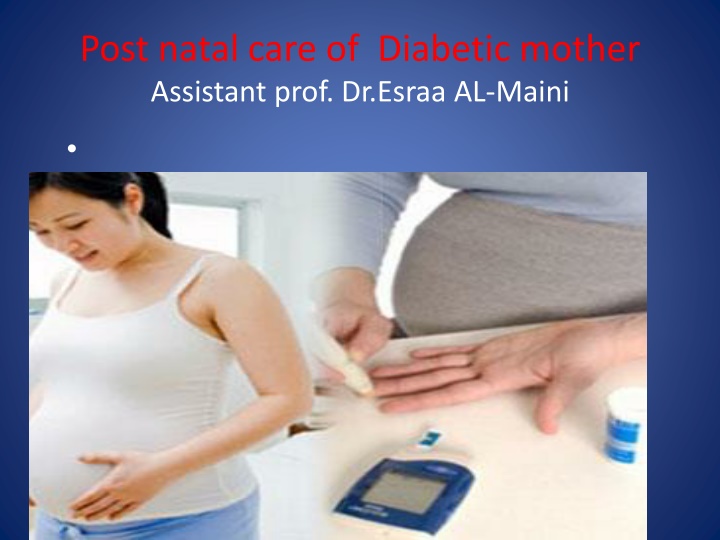
Postnatal Care for Diabetic Mothers: Guidelines and Recommendations
Learn about the postnatal care recommendations for diabetic mothers, including blood glucose control, medication management, breastfeeding, and contraception. Find out how to manage insulin levels, safe medication options, and the importance of follow-up care postpartum. Get insights on gestational diabetes and future pregnancy planning.
Download Presentation

Please find below an Image/Link to download the presentation.
The content on the website is provided AS IS for your information and personal use only. It may not be sold, licensed, or shared on other websites without obtaining consent from the author. If you encounter any issues during the download, it is possible that the publisher has removed the file from their server.
You are allowed to download the files provided on this website for personal or commercial use, subject to the condition that they are used lawfully. All files are the property of their respective owners.
The content on the website is provided AS IS for your information and personal use only. It may not be sold, licensed, or shared on other websites without obtaining consent from the author.
E N D
Presentation Transcript
Post natal care of Diabetic mother Assistant prof. Dr.Esraa AL-Maini
Postnatal care of diabetic mother Blood glucose control Medicines Breastfeeding Contraception
Women with insulin-treated pre-existing diabetes -Should reduce their insulin immediately after birth - Monitor their blood glucose levels carefully to establish the appropriate dose. -Explain to women with they are at increased risk of hypoglycaemia in the postnatal period, especially when breastfeeding, and advise them to have a meal or snack available before or during feeds.
Should discontinue blood glucose-lowering therapy immediately after birth.
who are breast feeding can resume or continue to take metformin and glibenclamide immediately after birth, But should avoid other oral blood glucose-lowering agents while breastfeeding.
Women with diabetes who are breastfeeding should continue to avoid any medicines for the treatment of diabetes complications that were discontinued for safety reasons in the preconception period.
Follow-up after birth Women with pre-existing diabetes -Refer women back to their routine diabetes care arrangements. -Remind women with diabetes of the importance of contraception -The need for preconception care when planning future pregnancies.
Women diagnosed with gestational diabetes Test blood glucose to exclude persisting hyperglycaemia before they are transferred to community care. Remind women who were diagnosed with gestational diabetes of the symptoms of hyperglycaemia Explain the risks of gestational diabetes in future pregnancies, and offer them testing for diabetes,when planning future pregnancies.
women who were diagnosed with gestational diabetes and whose blood glucose levels returned to normal after the birth: Offer lifestyle advice (including weight control, diet and exercise).
women who were diagnosed with gestational diabetes and whose blood glucose levels returned to normal after the birth: Offer a fasting plasma glucose test 6 13 weeks after the birth to exclude diabetes If not, offer a fasting plasma glucose test, or an HbA1c test if a fasting plasma glucose test is not possible, after 13 weeks . Do not routinely offer a 75 g 2-hour OGTT.
For women having a fasting plasma glucose test as the postnatal tests FBS; level below 6.0 mmol/litre : -They have a low probability of having diabetes at present -They should continue to follow the lifestyle advice given after the birth -They will need an annual test to check that their blood glucose levels are normal -They have a moderate risk of developing type 2 diabetes, and offer them advice and guidance NICE preventing type 2 diabetes 11
Fasting plasma glucose level between 6.0 and 6.9 mmol/litre Advise women with a that they are at high risk of developing type 2 diabetes, and offer them advice, guidance and interventions in line with the NICE guideline on preventing type 2 diabetes 12
Fasting plasma glucose level of 7.0 mmol/litre or above 1. Advise women with that they are likely to have type 2 diabetes, and offer them a diagnostic test to confirm diabetes. 13
For women having an HbA1c test as the postnatal test: HbA1c level below (5.7%) that: They have a low probability of having diabetes at present They should continue to follow the lifestyle advice given after the birth They will need an annual test to check that their blood glucose levels are normal They have a moderate risk of developing type 2 diabetes, and offer them advice and guidance in line with the NICE guideline on preventing type 2 diabetes[8. 14
HbA1c level (5.7% and 6.4%) They are at high risk of developing type 2 diabetes, and offer them advice, guidance and interventions in line with the NICE guideline on preventing type 2 diabetes. 15
HbA1c level (6.5%) or above They have type 2 diabetes and refer them for further care. [new 2015] 16
-Offer an annual HbA1c test to women who were diagnosed with gestational diabetes who have a negative postnatal test for diabetes -Offer women who were diagnosed with gestational diabetes early self-monitoring of blood glucose or an OGTT in future pregnancies. -Offer a subsequent OGTT if the first OGTT results in early pregnancy are normal
Contraception Efficacy is highest for long term contraceptive methods Somewhat less high for short-term hormonal therapies (for which daily, weekly, monthly or quarterly dosing may affect adherence and, thus, efficacy) And lowest for barrier or behavioral methods. 18
Centers for Disease Control and Prevention (CDC) for assessing contraceptive safety : 1 = No restriction for the use . 2 = Advantages generally outweigh the theoretical or proven risks. 3 = Theoretical or proven risks usually outweigh the advantages 4 = Unacceptable health risk. .
Sub dermal implant IUCD LNG-IUS Long-term methods very high safety rating for patients with diabetes mellitus, regardless of severity of disease
The Copper T 380A( is rated by the CDC as safety category 1 ) for all patients with diabetes mellitus, regardless of severity of disease The duration of action of the Copper T 380A is listed as 10 years Safty in nulliparous and parous women alike 21
LNG-IUS With a CDC safety classification of category 2(meaning the advantages of using this contraceptive generally outweigh the theoretical or proven risk ) excellent contraceptive choice for most women with diabetes mellitus , regardless of the severity of their diabetes or related co morbidities , even for women at risk of thrombophilia and young or nulliparous women..
LNG-IUS does not change metabolic parameters. A study comparing the LNG- IUS with the Copper T 380A showed no differences in daily insulin requirement, HbA1C, or fasting blood sugar levels after 12 months use
Subdermal implant is safe for women with diabetes mellitus, prevent pregnancy for as long as three years (CDC safety category 2)
In a study of metabolic effects of the subdermal implant in women with diabetes mellitus, there was a -statistically significant reduction of total serum cholesterol, -Carbohydrate metabolism was unchanged - no aggravation of vascular lesions was noted
pill patch ring Combined hormonal contraception
CDC safety classification of category 2 (advantages generally outweigh the theoretical or proven risk ). Pill Patch Ring For Diabetes mellitus patients without vascular disease end-organ damage
Oral contraceptives have shown no change in levels of HbA1C or degree of nephropathy and retinopathy, compared to women with T1DM who did not use oral contraceptives. These findings suggest that these mediations did not accelerate vascular disease in the patients vascular disease or other longstanding illness With limitation in case of patch :women weighing more than 90 kg had a greater failure rate than women with weight less than 90 kg
Unlike use of oral contraceptives, use of the vaginal ring has resulted in no statistically significant change in total cholesterol or HDL-C levels though a continued elevation in triglyceride levels has been noted with the ring.
For women with diabetes in whom vascular co-morbidities have developed. In patients who have evidence of end-organ damage In patients had diabetes mellitus for more than 20 years, combination therapy is usually not recommended unless other contraceptive options are not available or acceptable CDC 3/4
Depot medroxyprogesterone acetate (DMPA) CDC safety category 2 In women without vascular disease or other longstanding illness DMPA has adversely affected carbohydrate and lipid metabolism in patient with long standing of disease or vascular disease It has a CDC safety rating of category 3, meaning that risks outweigh benefits
Progestin only pills safety classification of category 2 for all patients with diabetes mellitus with or without vascular appropriate choice for individuals who have diabetes with hypertension or vascular disease. Because this contraceptive method does not interfere with lactation, it is often chosen for breastfeeding women during the immediate postpartum period disease.
Thank Thank you you 33






















